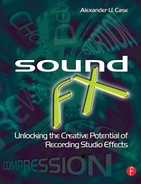″She′s so swishy in her satin and tat
In her frock coat and bipperty-bopperty hat.
Oh God, I could do better than that.″
— ″QUEEN BITCH,″ DAVID BOWIE, HUNKY DORY (RCA RECORDS, 1971)
The piano is nothing short of a miracle. Most weigh more than 1,000 pounds and hold in check more than 10 tons of string tension. Its very existence is an impressive accomplishment for the instrument maker. Able to reach about as low and as high as any note that can be written into a musical score, the piano very nearly possesses the full musical range needed by all of western European music. It is an industrial-strength machine with extraordinary artistic sensibilities.
For the recording engineer, the piano is something of an enigma. Possessing broad spectral abilities, extraordinary dynamic range, complex and dynamic harmonic structure, percussive sharp attack, and signature decay, the piano represents a range of sonic capabilities that fills the audio window (see Chapter 3). An instrument almost without limits, it presents the engineer with open-ended opportunities and seemingly unanswerable questions. This chapter studies some common production approaches to the piano, illustrating not only some valid signal-processing techniques specifically for the piano, but also a way of thinking through an instrument that engineers at all levels might find helpful on this and other instruments.
If the piano were invented today, it probably would not catch on. Priced more like an automobile than a musical instrument, possessing no musical instrument digital interface (MIDI) jacks, requiring constant (and laborious) tuning, and unavailable in a rack version, the mother instrument asks much of us. In the hands of mere average musicians, it is difficult to play expressively; there is no mod wheel, no volume pedal, and no vibrato.
While talents from Germany′s Beethoven to Peanuts′ Schroeder embraced the piano and helped it earn its place as one of music′s most important instruments, some of the issues described above have begun to take their toll. Courtesy of the convincing value and convenience of MIDI-triggered sample playback devices, the word ″piano″ often describes a set of samples or synth patches, not an instrument full of wood, wire, steel, and felt. Fair enough. Few musicians, your author included, are willing to hoist a piano into the back of the wagon for the next general business gig.
Engineers who have not had many opportunities to record a piano and really spend some time with one need not worry. Though it is a daunting instrument to record and mix, it pays rich rewards. This chapter studies some approaches to this enigmatic instrument so that any recording engineer can learn to make accurate, beautiful, unique, weird, or ____ (insert any preference here) recordings quickly, leveraging what may be limited (and pricey) time in the increasingly rare piano-equipped studio.
Before the microphones are selected and placed around the piano, a more important issue should be resolved first. What is the piano to sound like? A piano in a room presents an opportunity to record any of a number of very different sounding instruments. The engineer′s approach to recording and mixing the instrument can dramatically affect the sound of the instrument. As moving microphones is more time consuming than scrolling through patches, it is wise to begin with a rather specific goal in mind.
It is essential to view the piano within the context of the song. Production, composition, and arranging decisions must be made regarding the feeling to be conveyed, the piano′s contribution to the story of the song. Engineering goals for its placement in the mix should be envisioned. These strategic questions should be asked of all pieces of the arrangement of any pop song before the tactics of the multitrack recording session are detailed. The piano requires special attention because it is so very flexible.
It is the very definition of a full spectrum instrument. It is essentially capable of playing throughout the entire musical range. Its harmonic content can easily fill the top, bottom, and middle frequencies of the entire mix. Ah, such options. But such options require some decision making. If the song is not solo piano, then the piano must leave room for the other players. That means, first, limiting the musical part itself so that it interacts with and complements the other instruments musically. Second, it requires restraining and shaping the sound of the piano so that it finds its place in the ensemble sonically.
The musical issues are left to the players, composers, and arrangers. It is the engineer′s responsibility to look more closely at the sonic issues. It is useful to consider the piano′s place in the mix along three broad categories: spectrum, image, and envelope. These are not wholly independent variables as adjusting one property likely changes another. In search of some semblance of order in the heat of a busy recording session, it helps to break the decision into these useful components.
Spectrally, the piano can pretty much cover the entire audible range, from rich and warm low end, to a shimmering high end, and everything in between. Grand pianos thunder below 30 Hz while offering harmonics above 10,000 Hz. While most of it is in the hands of the instrument maker and the performer, the engineer should at first seek to achieve a balanced use of spectrum. Except as a special effect, it is generally undesirable to allow any narrow range of frequencies to overpower any other range of frequencies in the overall sound. All of the frequency elements that make up the unique timbral signature of the piano need to be persuaded to play fair with the rest of the spectrum.
Microphone selection and placement do the most to determine this, but equalization (EQ) (see Chapter 5), gently applied, gives the engineer finer control. In general, wide-bandwidth (low Q) parametric EQ is gently (± 6 dB or less) applied.
With the full spectral palette of the piano available and under control, the engineer can greatly improve a complicated mix by selecting specific frequency regions to highlight and/or others to deemphasize. Again, the primary tools for accomplishing this are microphone selection, microphone placement, and EQ. When two instruments play in similar frequency ranges continually, at the same time, there is the chance to rather aggressively filter one of them. It would be essential to avoid the low-end build-up that might occur when a gorgeously rich, left-hand oriented piano part competes with a six-string chorused bass over a kick, tom groove. Such a thick arrangement demands that something in the bottom two octaves (20–80 Hz) be sacrificed. The piano tolerates this quite well. If the kick, toms, and bass are unrelenting, and the piano rarely if ever plays without them, then something of an illusion can be created. Reduce the low-frequency content of the piano (perhaps using a shelving EQ attenuating 6–12 dB below approximately 80 Hz) to make room in the mix for these other low-frequency tracks. Distracted by the now clarified low end of the bass, kick, and toms, listeners may not notice the low-frequency reduction to the piano sound. The listener′s imagination — built on experience with the instrument, plus maybe a little wishful thinking — fills in the missing spectrum. The net result is that the piano sounds full and natural yet no longer competes with bass, kick, and toms.
At the high-frequency end of things, if the session ran out of time and failed to track to the intended tambourine or shaker performance that was meant to be added before the drummer left town, then the mix engineer might be free to emphasize a tasty part of the piano sound anywhere in the 6- to 12- kHz range; the delicate high end of a ribbon microphone or a small diaphragm condenser might be in order. Freed of competition in that high-frequency range, the piano welcomes a high-end highlight.
If piano and acoustic guitar compete, playing similar musical parts, try a high-pass filter or low shelf cut on the acoustic guitar to get it out of the way of the piano from about 200–400 Hz and below. The bright, metallic sound of the acoustic guitar is distinct from the round, rich warmth of the piano. Similar parts play together yet each instrument is identified and enjoyed easily within the mix through unique spectral processing.
Engineers who work frequently on music that includes synths and samplers have no doubt experienced the horror of the synth patch that ate the mix. Many patches — strings and pads are most often guilty — are mixes in and of themselves. They are nicely balanced from 20 Hz to 20 kHz and fill the entire stereo image with their lush swirliness. This creates a great sounding patch, when enjoyed all alone. In the context of a mix, however, these sounds present such broad spectral content that they are unmixable.
The piano commits a similar sin if the audio engineer is not careful. There is a certain microphone manufacturer based in Evanston, IL, that makes a microphone often accused of being appropriate for any application. This includes the piano. Throwing a $100 microphone on a multithousand dollar instrument might feel logically inconsistent. Expensive pianos sound great through expensive microphones, to be sure. However, the less expensive microphone may create a tone color that sounds just right. The presence emphasis of a Shure SM57 can pull the piano forward in the mix just as it does the Marshall stack.
WARNING: Applying EQ to a piano will at times feel a bit like building sand castles. Just as the sound takes shape, it shifts and moves. A lot of hard work seems to disappear and it is time to start over. The spectral content of the piano changes over time. This is part of the beauty, and the curse, of the instrument. A single note or chord, allowed to sustain indefinitely, will have harmonics waft in and out slowly, over time. No other instrument offers this property to this degree. A complex set of harmonics, changing over time, coming and going, some getting softer while others get briefly louder, is all part of the pianoness of the piano. This leaves the engineer applying spectral processing to a moving target. Finding the right boost and cut and the right frequency with the right bandwidth takes a bit of luck, a bit of faith, and a strong engineering sense of what is needed. Listen patiently and expect to be frustrated at first.
Of course the piano demands more engineering resources than microphones and equalizers. Audio engineers achieve new heights sonically on the piano through careful use of stereo placement.
The stereophonic image of the piano sound is probably the best weapon for bringing clarity and unity to a mix. To discuss image for the piano, it is important to understand what left and right mean.
For a drum kit, left might mean the drummer′s left. However, as the drummer typically faces the audience, the drummer′s left is the audience′s right. Left/right confusion sneaks in. Left and right for drums is sorted out by choosing the drummer′s perspective or the audience′s perspective.
Left and right are straightforward concepts for an orchestra — the conductor′s and audience′s definitions of left and right are the same and translate well to loudspeakers. But what is left and what is right on the piano? Listeners might be sitting at the piano bench (player′s perspective). Listeners might be in the audience looking directly at the open lid with the piano player to the left (audience′s perspective) More fun still, listeners could be looking straight down on a piano with the lid removed entirely (Heaven′s perspective). With the piano, these are all valid recording and mixing approaches. There are no strict rules to follow, only creative options to pursue.
Carefully Defining the width and placement of the image will help bring order to a mix. The center is always the most challenging. In particular, sorting out the competition for the middle frequencies can be made easier by thinning out the traffic in the middle of the stereo field. Two approaches to consider are to isolate or to contrast.
Isolation is achieved by panning midrange-hogging instruments (even stereo tracks of them) to different locations. Left-right separation reduces the spectral masking (see Chapter 3). The lead vocal and solos typically go to the center, so it can be helpful to pan the rhythm section to locations hard left and right. Laws of pop mixing (which of course do occasionally need breaking) require leaving the vocal unquestionably front and center. It follows that one could then put the guitars on one side and the piano on the other (Figure 14.1).
On the other hand, contrast is created by making one instrument spacious and enveloping with a large stereo image, perhaps wider than the loudspeakers (using fully panned stereo or doubled tracks, wide and enveloping stereo reverb, stereo phaser/chorus effects, and so on) while the competing instrument is a more precise point in space (mono, dry, compressed) (Figure 14.2). The piano is capable of both imaging extremes. Record and mix the piano toward a goal from the start — a pinpoint piano or a panoramic piano — and all elements of even a complicated mix can be better enjoyed.
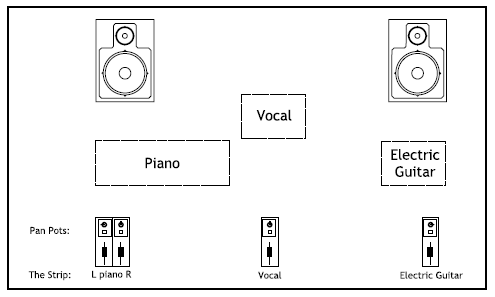
![]() Figure 14.1 Separating parts through isolation panning.
Figure 14.1 Separating parts through isolation panning.
![]() Figure 14.2 Separating parts through contrasting images — wide piano.
Figure 14.2 Separating parts through contrasting images — wide piano.
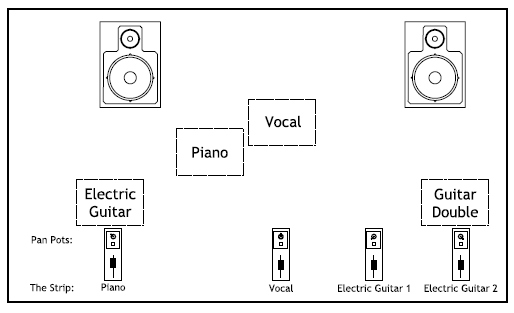
![]() Figure 14.3 Separating parts through contrasting images — pinpoint piano.
Figure 14.3 Separating parts through contrasting images — pinpoint piano.
If it is late at night and no one can tell left from right, do not be afraid to track a mono piano. Often the essence of the piano can be captured by a single well-placed microphone (Figure 14.3). Alternatively, a low-fidelity-by-design sort of sound might be the right piano sound for the tune. Open the lid and place a microphone right in the middle of the soundboard, starting about two or three feet above it, and a surprisingly effective piano sound can be found. The single microphone approach can benefit from the use of unusual microphones, noisy and distorted use of recording media, heavy compression, etc. File under special effects, but know the piano rewards this type of approach.
Lastly, consider the dynamics this instrument can offer. Again, musical dynamics (e.g., mf decrescendo to ppp) is left to the musical judgment of the players, composers, and producers. The amplitude envelope is the creative variable here: the attack, sustain, and decay of the instrument (Figure 14.4). All that time foraging through the parameters of the synths and samplers and all those hours squinting at the screen of the digital audio workstation, offers an unexpected payoff on the piano. Creating, looping, editing, and simply staring at sampled waveforms gives an engineer a useful way to think about sound. The shape of the sound wave (called the amplitude envelope, and often just the envelope) shows the recordist a bit about how the sound might fit into the mix. Instruments fall somewhere on a range between clave (very short attack with essentially no sustain and nearly instant decay — the analog meter barely twitches) and rhythm electric guitar (every engineer who has recorded this can admire how the meter just sits at one level during the entire song). Sharp, spiky attacks will poke out of the mix naturally and need not be especially loud in the mix (this is particularly true for sounds panned far to one side). Smooth and continuous sounds need careful placement to remain audible without covering other elements of the mix. The piano, ever the challenge, can cover quite a variety of shapes: percussion to pad.
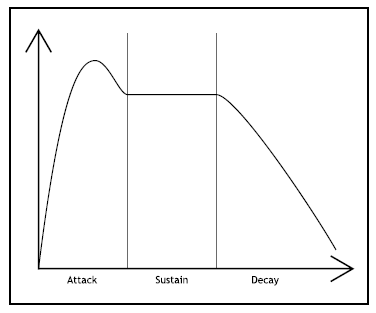
Consider the attack side of the envelope. The very striking of the hammer against the strings in the piano is often emphasized through microphone placement. The sharp attack enables the piano to cut through a wall of guitars; the contrast in envelopes (piano versus guitars) is the trick here. As discussed in Chapter 6, there is more than one way to sharpen the attack. The piano all but begs engineers to patch in that most wonderful studio tool, the compressor. Heavy compression (low threshold with 10 : 1 ratio or higher) with a medium to slow attack and slow release is all that is needed. The piano note sounds. Several milliseconds later (depending on the attack time of the compressor), the compressor kicks in and yanks the signal down in level, changing the signal′s envelope. Through this compressor action, the attack is sharpened (as described in Figure 14.5). Perhaps the attack was entirely fabricated — a smooth and gentle envelope turned mean. Engineers should explore a range of attack times, ratios, and thresholds in search of a variety of sounds caused by alteration of the amplitude envelope.
At the other end of the envelope lives still more opportunity for signal processing: decay. The piano, score, and performance will determine the character of the sustain of each note. Sixteenth-note funk parts are expected to have a different envelope than whole-note, textural accompaniment. The release parameter of the compressor offers the engineer a chance to modify the sustain. Keeping the release time medium to fast can have the effect of lengthening the decay time. One may tweak it into a natural or a bizarre sound.
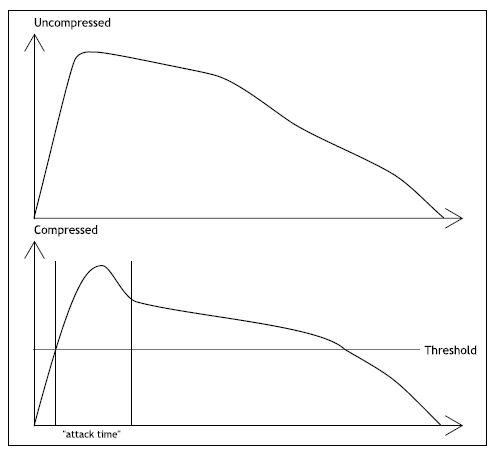
![]() Figure 14.5 Sharpening the attack through compression.
Figure 14.5 Sharpening the attack through compression.
The piano can be converted into an almost bell-like sound through use of a very quick attack setting, fast release time setting, and very high (limiting) ratio. Each note of the piano possesses a soft, almost nonexistent attack, followed by a very long, seemingly infinite decay. This radical use of limiting pairs nicely with the use of an unusual old microphone.
Finally, consider a more classical approach to recording the piano. Instead of using close microphone techniques on the piano, distant pairs of microphones are preferred. This aesthetic values the sound of the piano in a hall. Perhaps it is better described as the sound of the piano and the hall. Distant microphones record a greater proportion of the early reflections and reverberation in the hall and less of the direct sound of the piano itself. Among other things, this approach captures a radically different envelope, unlike any of the close microphone approaches discussed above. There is no chance to hear the hammers hitting the strings with this approach. The decay of the instrument is augmented by the decay of the hall′s reverb. In the home studio, engineers approximate this through the addition of the studio′s best sounding hall reverb, built on a not-too-aggressive close microphone approach.
The piano tolerates all extremes of recording approaches. One can place microphones very near the hammers, and apply a long hall reverb patch and use severe compression. Distortion and wah pedals are sometimes appropriate, as well. The piano welcomes radical approaches, but demands careful control. First target the sound most appropriate to the tune and to the mix, and follow any path necessary to get there.
An instrument as important as the piano has inspired many imitators.
There is no such thing as an ″acoustic″ piano. Pianos are acoustic by definition. If it is a box full of silicon and solder rather than wood and wire, then, and only then, does it need the extra adjective (e.g., a synth piano or a digital piano). Such are the rants of hopelessly romantic piano lovers like your author, but there is an important point to be made here. That heavy piece of wood and steel may be difficult to move, but its sound is easy to shape. A producer or engineer may want an ″acoustic″ piano sound that evokes the feeling and perhaps the image of an honest to goodness piano in an honest to goodness room. Alternatively, they may want a sound whose personality is recognizable as a piano but whose overall sound has been aggressively manipulated to suit some creative desires. Discussed above were the many techniques for recording and mixing the piano toward a range of options. To be complete, we also consider the less expensive version.
The alternative to the real-life piano is the digital or MIDI piano: the sampled/synthesized piano patches that live in synth racks. While often owing some of their heritage to an actual piano somewhere in their past, these sounds are in fact pretty far removed from ″acoustic″ reality. In addition to being subjected to all of the processes discussed above for true piano, it is useful to explore some additional spectral, image, and envelope opportunities offered by these pianolike devices.
For engineers whose synthesis programming skills are sharp, there is opportunity to really take the piano out, spectrally. With several types of effects built into the synth architecture of many digital pianos, it is easy and rewarding to apply sweeping resonant filters to the pianolike sound. Layered with strings or other sounds, the piano sinks into a deeper texture.
The stereophonic image of a digital piano warrants special attention. Probably the most obvious peculiarity/feature of the digital piano is the panning distribution of the notes. Each note of the typical piano patch occupies a location in the stereo field that very closely follows the position of each individual (ivory or, more likely, plastic) key. This is standard, dare we call it traditional, practice for digital pianos. With the popularity of synths and the impracticality of pianos, there is some risk that the true sonic image of a piano is being replaced with this synthesized/sampled nonreality. Surely the engineers who recorded the original piano sounds that form the basis of the sample playback piano synthesizers noticed that the notes of a piano come from the entire piano, not from such precise points in space. The sound of the individual notes certainly does not come from the black keys and white keys themselves. The sound does not laser beam its way from the string to the ears. It is wonderfully more vague than that. It is the soundboard, all 15 square feet or so stretching out before the pianist, which radiates the sound. Both single notes and thick chordal voicings swell out from the soundboard (above and below it) swirling and bouncing throughout the structure of the piano and the room, finally reaching the listeners as a complex sound field in which the localization of individual notes is anything but discrete.
So what is an engineer to make then of this ridiculous note-by-note, left-to-right, continuum-panning paradigm that pervades the digital pianos? Leverage it. It is an opportunity. Real pianos cannot do this. Digital pianos can. The humble panning effect is used on pretty much every element of every multitrack production, but in much simpler, broader ways: lead vocal, snare, kick, and bass panned center; acoustic guitar panned right; horn section panned left, etc. Digital pianos upgrade panning to a note-by-note detail that few other instruments can offer. The clever composer takes advantage of it. The creative engineer might try to show it off. Digital pianos (and most any synthesizer or sampler output) represent an opportunity for audio engineers to utilize the convenience of sample playback to make more intricate use of the stereo field. Like hard-panned guitar doublings, or ping-ponging vocal delays, digital piano panning can be a great use of the two speakers one has to work with.
WARNING: Do not pretend it is a piano (an ″acoustic″ piano). It simply is not. It cannot be. In fact, when arpeggios and glissandos pan across the stereo landscape, a digital piano is identified. If the creative goal is a real piano, this panning standard will undermine the illusion, and can only be used as a special effect, which likely is not valid. If the musical desires of the production team include this note-by-note stereophonic image, then a piano should not be used; record a MIDI piano instead. They are two different instruments. An engineer should consciously choose the one that meets the needs of the music and the mix.
Should a still more interesting stereo image effect be desired, one may further exploit the power of the sound module. Chords need not sit still as a low-to-high, left-to-right image. LFOs (low-frequency oscillators, like those found in the modulation section of most delay lines, see Chapter 9) or randomizing features can give the MIDI piano a more varied sonic image. It may be necessary to narrow the total spread of the pan pots to exercise some control over a radical, motion-filled image and confine the total space of the pianolike sound to a small region within the stereo field. Imagine frenetic guitar arpeggios on the right, radical-hyper-swirling-virtual piano on the left. That is easier to make sense of than having both instruments move and dance across the entire left to right spectrum. Confining them makes it easier to enjoy their motion. When musicians use synth/sample playback units for pop-music parts, anything goes, so an engineer must at times seek out the more unusual effects opportunities these devices make possible.
On the envelope front, digital pianos offer another signal processing opportunity: reverse piano. Sneaking in with a gradual attack, sustaining with a rich piano tone, and ending abruptly, the reverse piano gives the arranger and the engineer a lot to work with. Flip those samples so that they play backwards, use a sequencer to get the part right, and an attention grabbing element drops into the arrangement — one that would be very difficult, if not impossible, to create with a piano.
The piano retains its significance today, despite it price, heft, and mechanical complexity. It is still the instrument on which most of us compose. It is the instrument in most every classroom at most every music school. It has an important place in the gear intense, pop-music world. The piano on its own represents a vast range of sounds, an infinite bank of patches that respond well to any kind of sound effect an engineer can imagine.
